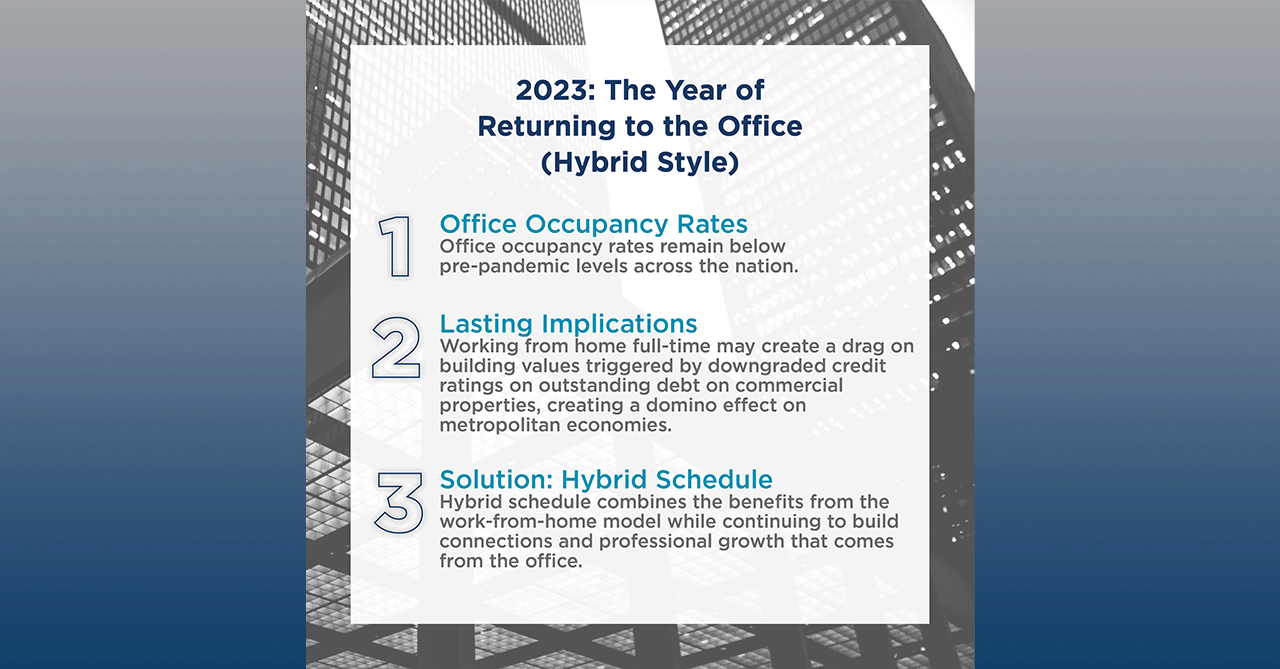2020 was the year that flipped the office upside-down and created the need for the work-from-home model around the world. As we continue to recover from the pandemic, 2023 will be the year workers return to the office as we settle into this new normal. Many organizations debate what the “Great Return” of employees returning to the office will look like. Cushman & Wakefield’s Global Lead for Workplace Experience, Bryan Berthold, put it best “it’s time to change ‘RTO’ to mean ‘Reason for the Office’.” There is no denying that the hybrid model is an indefinite product of the pandemic. It combines the benefits of the work-from-home model while continuing to build connections and professional growth that comes from the office environment.
The traditional model of in-person work has irreplaceable benefits for connection. Employees come together and work as a team, collaborate, brainstorm, and connect to company culture. It is especially vital for the younger generations beginning their careers to be in the office to build experience, mentorships, and a professional network. The work-from-home movement has seen positives as well, such as improving employees’ well-being, family life, and the potential for focusing on individual productivity. The pandemic has ultimately changed how people work and perceive the office, and it is time for company leaders to consider the value of a hybrid workplace.
Office occupancy rates remain below pre-pandemic levels across the nation. While larger cities’ office attendance has been increasing in the past year, reaching 49% of pre-pandemic attendance in October of 2022, many cities have yet to reach 50% of pre-pandemic office use. The implications of working from home full-time may create a drag on building values triggered by downgraded credit ratings on outstanding debt on commercial properties, creating a domino effect on metropolitan economies. In light of this economic impact, in December, The Real Estate Roundtable, an organization advocating for real estate owners, urged the Biden administration to lead by returning federal workers to the office to reignite commerce and support retailers and other small businesses in office centers.
Companies are now implementing hybrid work policies, and many are beginning this year. For example, Bob Iger, CEO of Disney announced workers who are currently on hybrid-office schedules must return to corporate offices at least four days a week beginning in March. Many other companies are following suit and are calling employees back into the office, such as Twitter, Uber, Snap, Vanguard Group, and JPMorgan Chase. Bob Iger said, “I’ve been reminded of the tremendous value in being together with the people you work with…Nothing can replace being physically together, nor the opportunity to grow professionally by learning from leaders and mentors.”
Tom Nieman, office specialist at Cushman & Wakefield | PICOR, provided the following insight: Our hometown Tucson market has experienced much of the same, however, the experience is a bit different. The larger office tenants, such as call centers and back-office users, have found getting employees back to the office more difficult or even ineffective. Fortunately, most of Tucson’s employers are smaller and needed fewer, if any, of their employees to work from home during the pandemic. However, there still seems to be a fair amount of excess space in many offices, as employers continue working towards enticing their employees back. In the long run, the Tucson market should see the majority of workers come back to the office, at least on a 3-to-4-day hybrid plan, as both employers and employees realize the importance of collaboration, mentorship, culture, and relationships.
Sources:
Berthold, Bryan. “Bryan Berthold on Linkedin: #Rto #Reasonfortheoffice #Wfh #Covid #Wellbeing #Executives #Leadership…: 15 Comments.” Linkedin, 6 Dec. 2022, https://www.linkedin.com/posts/bryanberthold_rto-reasonfortheoffice-wfh-activity-7005973338833518592-IJdS?utm_source=share&utm_medium=member_desktop.
“Disney Orders Workers Back to Offices, Restaurants Delay Expansion, Consumer Inflation Expectations Cool.” CoStar News, 9 Jan. 2023, https://product.costar.com/home/news/shared/2133693470?utm_source=newsletter&utm_medium=email&utm_campaign=personalized&utm_content=p5&t=eyJhbGciOiJIUzI1NiIsInR5cCI6IkpXVCJ9.eyJjb250YWN0SWQiOiIxNjQ1MDM5NTEiLCJjdWx0dXJlQ29kZSI6ImVuLVVTIiwiaWF0IjoxNjczNDUxMzg1fQ.Lj8Q7wnKyo9trJXBAsp09cp-HSwJRKaVFjGqp-HcqOA.





